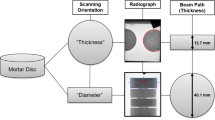Abstract
A major part of the infrastructure is constructed of Portland cement concrete. Nevertheless, many aspects of this material are still not well understood. The main constituent of hydrated Portland cement is a hydrous gel, with significant features on the nanometer scale, that tends to be unstable under vacuum. It is difficult to investigate with conventional instrumental methods. Neutron scattering methods possess unique capabilities to characterize cementitious materials and thus to resolve a number of long-standing issues. Among the applications, quasi-elastic neutron scattering is used to follow non-destructively the progress of the main hydration reaction and to determine the distribution of the water content among the various states: i.e. free, chemically bound, or physically trapped in the gel network. Quasi-elastic neutron scattering can also be applied to investigate the process of ice formation in the pore spaces. Neutron diffraction has been used to observe the development of hydrous phases as a function of time. Small-angle neutron scattering (SANS) proves to be well-suited to the characterization of the microstructure. This method is being used to determine the surface and volume fractal dimensions of the gel as a function of time and as a function of additives such as fly ash or silica fume. In addition, SANS has been applied to characterize silica aggregates for the potential for deleterious reactions in highly alkaline concrete. Aside from their application to specific problems, the combination of neutron scattering techniques is leading to new interpretation of the fundamental structure of the Portland cement gel.
Similar content being viewed by others
References
A. Neville, in Concrete Durability: Katherine and Byrant Mather International Conference, edited by J.M. Scanlon (American Concrete Institute, Detroit, 1987) p. 21.
G. Chengju, ACI Materials Journal, 86 (4) 341–353 (1989).
H.F.W. Taylor in Microstructural Development During Hydration of Cement, L.J. Struble and P. W. Brown, Eds. [Materials Research Society, Pittsburgh PA, 1987] pp.47–54.
S. Brunauer and S.A. Greenberg in Fourth International Symposium on the Chemistry of Cement,[Washington DC, 1960]. pp.135–165
D.H. Windsor, C.G. Windsor and C.D. Lawrence, Mag. Concrete Res., 26 (87) 65–72 (1974).
R.A. Livingston, D.A. Neumann and J.J. Rush, presented at the 1993 American Ceramic Society PAC RIM Meeting, Honolulu, HI, 1993 (unpublished).
H.F.W. Taylor, Cement Chemistry, Academic Press, NY (1990).
J. Teixeira, M.-C. Bellisent-Funel, S.H. Chen and A.J. Dianoux, Phys. Rev. A 31, 1913 (1985).
D.M. Smith, D-W Hua and W.L. Earl, MRS Bulletin, XIX (4) 44–48 (1994).
A. J. Allen and R. A. Livingston, in Proceedings of the Fifth Canmet/ACI International Conference on Fly Ash, Silica Fume, Slag and Natural Pozzolans in Concrete (American Concrete Institute, Detroit, 1995) edited by V.H. Malhotra (in press).
M. Kriechbaum, G. Degovics, P. Laggner and J. Tritthart, Advances in Cement Reseach, 6 (23) 93–102 (1994).
P.L. Hall, D.F.R. Mildner and R.L. Borst, Appl. Phys. Lett, 43 (3) 252–254 (1983).
W. Lerch, Basic Principles of Air Entrained Concrete, T-101, Portland Cement Association, Detroit (1960).
G.C. Robinson, Bulletin of the American Ceramics Society, 63[2] (1984) 295.
A. Ravaglioli and G. Vecchi, Assessment of the frost resistance of ceramic bodies by means of porosity meter tests, in: Pore Structure and Propertie s of Materials. Part IV, eds. S. Modry and M. Svata, Academia Press, Prague (1974).
M.Maage, Materials and Construction, 17 [101] (1984) 345.
ASTM Committee C-15, Standard Specification for Facing Brick (Solid Masonry Units Made from Clay or Shale), C216-91c, American Society for Testing and Materials, Philadelphia PA (1991).
S.A. Bortz, S.L. Marusin and C.B. Monk, Jr., A critical review of masonry durability standards, in: Proceedings of the Fifth North American Masonry Conference, ed. D.P. Abrams, The Masonry Society, Boulder CO. (1990).
T. Ritchie, II-3. Brick durability tests and the method of freezing, in: Proceedings Vth International Brick Masonry Conference, Washington, DC (1979).
D.H. Everett, Trans. Faraday Society, 57 (1961) 1541.
T. El-Korchy, D.L. Gress, R.A. Livingston, D.A. Neumann and J.J. Rush in Neutron Scattering in Materials Science, edited by D.A. Neumann, T.P. Russell and B.J. Wuensch (Mater. Res. Soc, Proc., Pittsburgh PA, 1995) (in press).
P. Sokol et al. Presented at American Ceramic Society Meeting 1994.
Author information
Authors and Affiliations
Rights and permissions
About this article
Cite this article
Livingston, R.A., Neumann, D.A., Allen, A. et al. Application of Neutron Scattering Methods to Cementitious Materials. MRS Online Proceedings Library 376, 459–469 (1994). https://doi.org/10.1557/PROC-376-459
Published:
Issue Date:
DOI: https://doi.org/10.1557/PROC-376-459




